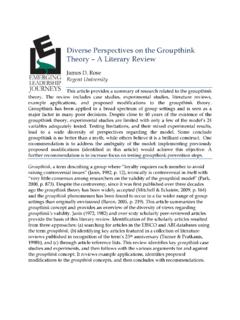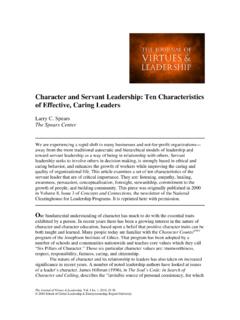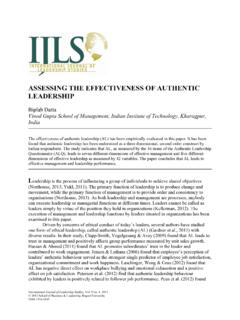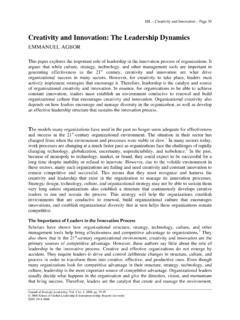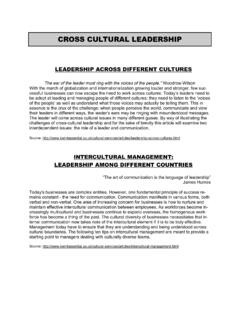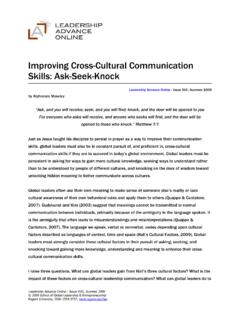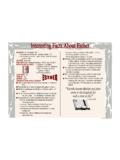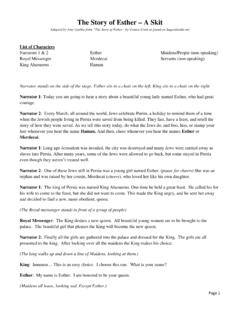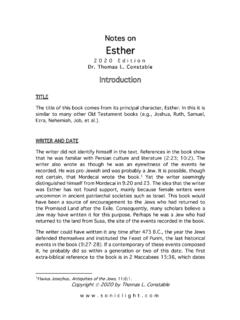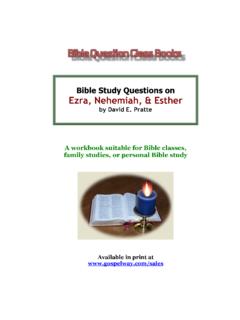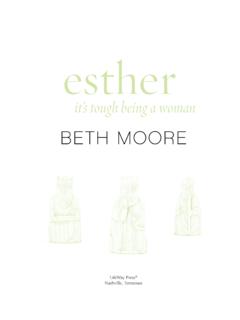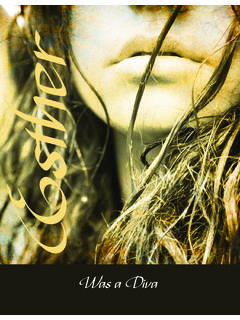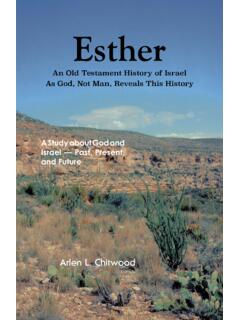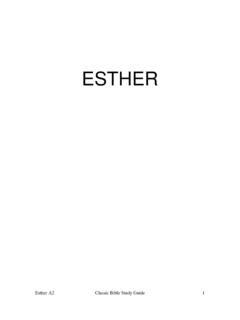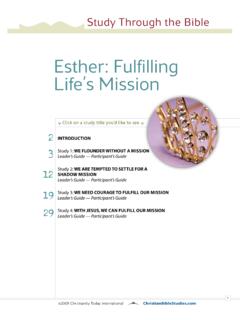Transcription of QUEEN ESTHER AS A SERVANT LEADER IN ESTHER 5:1-8
1 QUEEN ESTHER AS A SERVANT LEADER IN ESTHER 5:1-8 . OLUFUNMILAYO O. AKINYELE. This paper explores the leadership of the literary figure of QUEEN ESTHER and the importance of the story in the institution of the Festival of Purim. Cultural intertexture analysis, honor, guilt, rights culture, and challenge-response/riposte place ESTHER within the domain of a SERVANT LEADER demonstrating the leadership virtues Patterson identifies in her theoretical model of SERVANT leadership. Although ESTHER 's leadership fits within the framework of SERVANT leadership, her self-sacrificial leadership goes beyond it. Additional research is needed to demonstrate how ESTHER 's leadership model works within different socio-economic and multicultural contexts as well as how it fits within Bekker's proposed model of kenotic leadership. This paper examines the leadership of the literary figure of QUEEN ESTHER in her approach to King Xerxes to plead for the life of the Jews.
2 Hill and Walton indicate that the story of ESTHER was set during the Persian Empire of the early to mid-fifth century and conclude that it was written in the late fifth century 1 However, Gottwald suggests that 150-100 was the likely time frame when ESTHER was written. 2 He explains that Purim, referred to as Mordecai's Day, is first mentioned in the period 100-50 and associated with Nicanor's Day, when Jews celebrated a Maccabean 1. Andrew E. Hill and John H. Walton, A Survey of the Old Testament (Grand Rapids, MI: Zondervan, 1991), 238. 2. Norman K. Gottwald, The Hebrew Bible A Socio-Literary Introduction (Philadelphia: Fortress Press, 1985), 562. Journal of Biblical Perspectives in Leadership 2, no. 2 (Summer 2009): 51-79. 2008 School of Global Leadership & Entrepreneurship, Regent University ISSN 1941-4692. Akinyele/JOURNAL OF BIBLICAL PERSEPCTIVES IN LEADERSHIP 52.
3 Victory over the Syrians. 3 Gottwald states that at the time, relations between Jews and Hellenistic Gentiles were especially strained. 4 Bechtel surmises that the opening phrase this is what happened in the days of Xerxes (Est 1:1) implies a perspective after that fact. 5 Berlin notes that it provides the story of the origin of Purim, the blueprint for its celebration, and the authorization for its observance in perpetuity. 6. Although the more ancient festivals are historicized and their observance mandated by the Torah, Purim is historicized and its observance mandated by the book of ESTHER . 7. One distinction of this mandate from those in the Torah is that God did not command it like the ones in the Torah. 8 Berlin surmises that Purim is quasi-traditional, finding the intersection between an historical event, similar to those in the Torah, yet using the contemporary Persian practice.
4 She indicates that the form in which the holiday was instituted imitated the legal practice of Persia by means of a document written by the king or his authorized agent circulated throughout the empire. 9 Berlin concludes that the book of ESTHER , more than anything else, is responsible for the continued celebration of Purim. She indicates that it also made the way for the establishment of later holidays that, like Purim, could be instituted without divine command if they commemorated an event or served an important function in the life of the Jewish people. 10. The Festival of Purim, established as a celebration of the Jews's lives being spared, is still celebrated in modern times. Gottwald indicates that the book of ESTHER locates the origin of the Feast of Purim in a spectacular last-minute deliverance of all the Jews within the Persian Empire from a plot to annihilate them.
5 11 Yet, the origins of the Feast of Purim remain speculative. It was the association of an older festival, also called Purim and may have previously existed, with deliverance from anti-semitic programs in Maccabean-Hasmonean times that catapulted the Purim rites into prominence in Palestine and occasioned the Book of ESTHER . 12 Carruthers asserts that Purim celebrated Jewish deliverance in the Diaspora and explains that the symbols of reversals are interpreted theologically: the world turned upside down celebrates Jewish chosenness and the providential care of God over his chosen people. 13 Carruthers indicates that the Purim synagogue service frames how the story of ESTHER is 3. Ibid., 562. 4. Ibid., 562. 5. Carol M. Bechtel, ESTHER Interpretation: A Bible Commentary for Teaching and Preaching (Louisville, KY: John Knox Press, 2002), 3. 6. Adele Berlin, The JPS Bible Commentary: The Traditional Hebrew Text with the New JPS Translation (Philadelphia: The Jewish Publication Society, 2001), xv.
6 7. Ibid., xv. 8. Ibid., xv. 9. Ibid., xvi. 10. Ibid., xvi. 11. Gottwald, The Hebrew Bible, 561. 12. Ibid., 563. 13. Jo Carruthers, ESTHER Through the Centuries (Malden, MA: Blackwell Publishing, 2008), 11. Journal of Biblical Perspectives in Leadership 2, no. 2 (Summer 2009): 51-79. 2009 School of Global Leadership & Entrepreneurship, Regent University Akinyele/JOURNAL OF BIBLICAL PERSEPCTIVES IN LEADERSHIP 53. interpreted. 14 She points out that Deut. 25:17-19 is read on the Sabbath before Purim, Shabbat Zakhor, in order to tie the story to God's injunction to the Jews to Remember (zakhor) what Amalek did', attacking them on their journey from Egypt to Canaan (Ex 17). 15 Carruthers notes that the story inspires a memorial, and even for some a provocation of hatred. 16 Carruthers further observes that for Jews, the assertion of providence is key to the festival of Purim, at which God's care and supervision of his chosen people are celebrated.
7 17. Berlin notes that the book of ESTHER is a Jewish book reflecting Jewish experiences and aspirations. 18 She asserts that the main reason for the book of ESTHER is to establish Purim as a Jewish holiday for all generations. 19 Berlin points out that the book of ESTHER establishes the Jewishness of the holiday by providing a historical event of Jewish deliverance to be commemorated and an authorization, through the letter of Mordecai, for the continued commemoration of the event. 20 Regarding ESTHER , White concludes: She is a model for the successful conduct of life in the often uncertain world of the Diaspora. The fact that she is a woman emphasizes the plight of the Jew in the Diaspora: the once-powerful Jewish nation has become a subordinate minority within a foreign empire, just as ESTHER , a woman, is subject to the dominant male. However, by accepting the reality of a subordinate position and learning to gain power by working within the structure rather than against it, the Jew can build a successful and fulfilling life in the Diaspora, as ESTHER does in the court of Ahasuerus.
8 21. Roop summarizes the Jewish historical struggle: Living as a minority community, dependent on the attitude and actions of the majority, has kept Jews always in a precarious position. 22 Berlin emphasizes that ESTHER strengthens the ethnic pride of Jews under foreign domination. 23 Van Wijk-Bos indicates that the book of ESTHER is about sexism, the ideology of patriarchy. 24 She points out that the literary figure of ESTHER is a member of a vulnerable class in three ways: an orphan, a woman, and an alien who is a Jew. 25 Van Wijk-Bos states that from ESTHER we learn also about the 14. Ibid., 11. 15. Ibid., 11. 16. Ibid., 11. 17. Ibid., 32. 18. Berlin, The JPS Bible Commentary, ix. 19. Ibid., xv. 20. Ibid., xv. 21. Alice O. Bellis, Helpmates, Harlots, and Heroes, 2nd ed. (Louisville, KY: Westminster John Knox Press, 2007), 192. 22. Eugene F. Roop, Believers Church Bible Commentary: Ruth, Jonah, ESTHER (Scottdale, PA: Herald Press, 2002), 161.
9 23. Berlin, The JPS Bible Commentary, xxxv. 24. Johanna W. H. Van Wijk-Bos, Ezra, Nehemiah, and ESTHER (Louisville, KY: Westminster John Knox Press, 1998), 105. 25. Ibid., 105. Journal of Biblical Perspectives in Leadership 2, no. 2 (Summer 2009): 51-79. 2009 School of Global Leadership & Entrepreneurship, Regent University Akinyele/JOURNAL OF BIBLICAL PERSEPCTIVES IN LEADERSHIP 54. possibilities of overcoming the constraints designed by a patriarchal world and may discern the design of a pattern to overcome such constraints. 26 Roop discusses the importance of the story of ESTHER in addressing issues of gender: The role of women and their options in social and political contexts. 27 Roop points out that action in the political arena is inevitable even by those who, like ESTHER , prefer to avoid it and that the success of women in the social and political realm is especially difficult in cultures where men have decided who has access to the political arena, and also what strategies are available and permissible.
10 28 Van Wijk-Bos observes that the book of ESTHER demonstrates the landscape of all systemic oppression and prejudice everywhere 29 and shows where race prejudice leads. 30 Van Wijk-Bos further indicates that ESTHER provides an example of liberation through solidarity with victims of oppression. 31 She points out that her stand is all the more valiant because it is not taken heedlessly but after much hesitation and demurral. 32 Minorities in a larger society, such as African American women or immigrants in North America, have limitations placed on them in the social and political arenas. The story of ESTHER can be inspirational, helping to instill a sense of hope that, as minorities, they do not have to remain marginalized and can gain a measure of control over their own lives. The story of ESTHER is an important illustration for contemporary culture because it demonstrates effective leadership in the midst of difficult circumstances.

